Review of the Satina cucumber hybrid, which even a beginner can handle growing
The variety of varieties and hybrids often complicates, rather than simplifies, the gardener’s choice. Among the positive characteristics, Satin f1 cucumbers have advantages that can interest any vegetable grower, regardless of the scale of cultivation. And the increased demand in sales markets speaks of the extraordinary taste and benefits of this vegetable.
Description of the variety
Satin f1 cucumbers belong to the first generation hybrids. The culture was bred in Holland in 2007, and in 2009 it was entered into the State Register of the Russian Federation.
Reference! The first generation hybrid is obtained by crossing 2 parental varieties that are genetically different. Denoted by "f1".
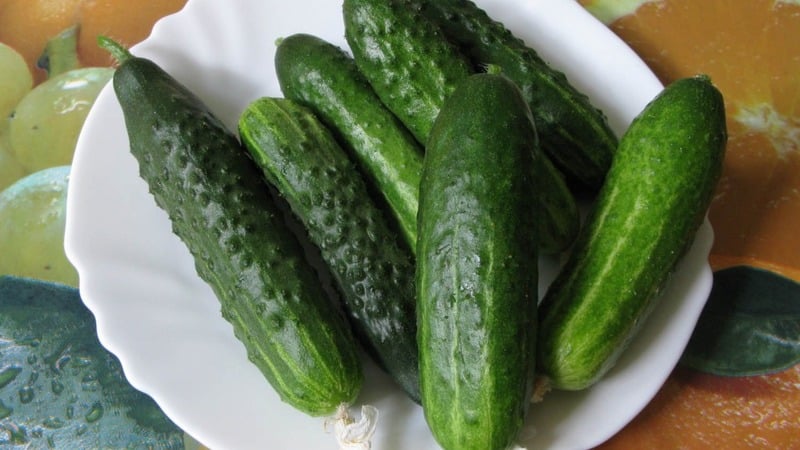
Distinctive features
Insects are not required to pollinate the hybrid, since the plant belongs to the parthenocarpic type and forms ovaries without pollination. It takes root well in greenhouses and open beds. Suitable not only for personal consumption, but also for breeding on an industrial scale.
Properties, benefits, calorie content
Cucumber contains numerous microelements that are beneficial and vital for the human body. These include: magnesium, calcium, copper, zinc and iron. The pulp of the vegetable is rich in vitamins A, C and group B.
The low calorie content of cucumber allows you to use vegetables for diets when losing excess weight.
Modern cosmetology continues to expand the scope of use of cucumbers and introduces cucumber extract and juice into numerous procedures.
Plant characteristics
The plant type is indeterminate, that is, with unlimited growth, average branching, female flowering. The leaves are large, rich green. The formation of the ovary is fascicular. Each bush bears 6 to 8 fruits.
According to the ripening period, the crop is classified as mid-early, since the first fruits ripen in 35-42 days.
The yield is high, 4-5 kg are harvested from 1 m², provided that 3-4 seedlings are planted.
The culture's genes contain persistent immunity to cladosporiosis (brown and olive spot), cucumber mosaic virus and bacteriosis.
Fruit characteristics
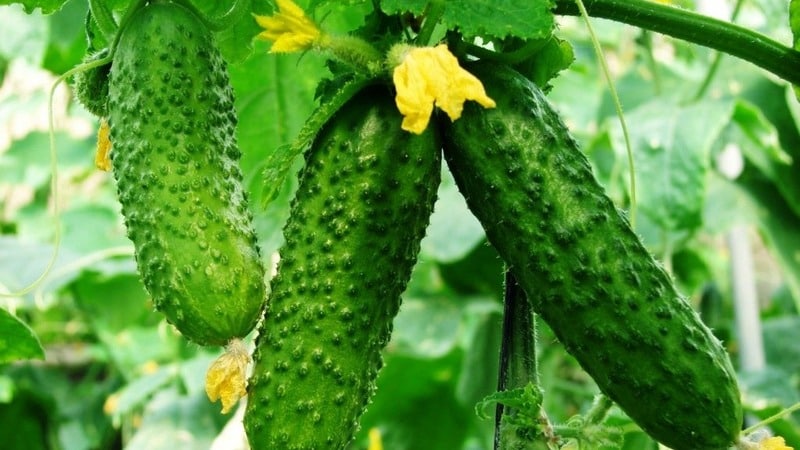
The average weight of the fruit is 95-105 g, the shape is cylindrical, the peel has large tubercles and dense pubescence. The color is dark green, the taste is excellent, without bitterness, the flesh is juicy and crispy.
The variety is perfect for industrial breeding, as the yield of marketable products is 95-98%. Transportation over long distances does not affect the taste and external qualities.
The use of ripe vegetables is universal. Cucumbers are a great addition to any fresh dish and do not lose their flavor in pickles, marinades and preserves.
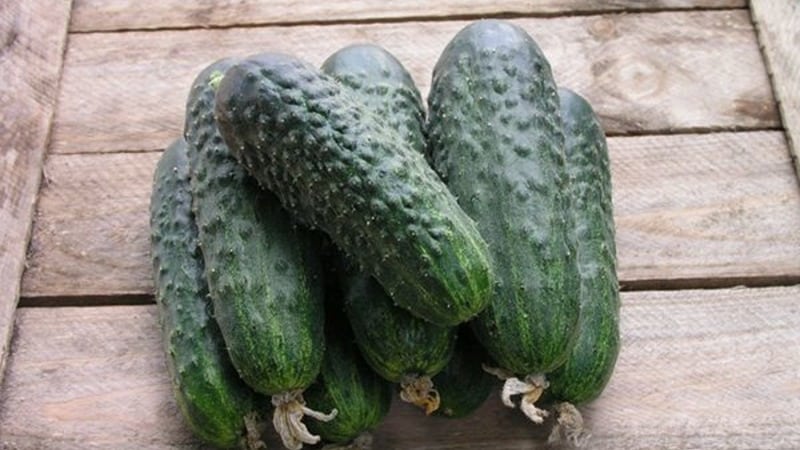
How to grow a hybrid yourself
Satin f1 cucumbers take root well in open ground, regardless of the planting method. The hybrid is planted directly in open beds or grown through seedlings. In any case, the culture will delight you with an excellent harvest.
Planting seeds in the ground
Seeds are sown in the ground at a soil temperature of 16-18 °C. First, the soil is dug up and saturated with a complex of mineral substances. The holes are prepared in advance, filling them one third with peat.
Sowing is carried out in the evening hours, after sunset. The seeds are planted to a depth of 1.5-2 cm, slightly moistened and covered with film until germination.
Preparing soil, containers and planting seeds for seedlings
Growing Satin cucumbers in seedlings comes down to standard activities. Seed material of hybrid crops is bought in specialized stores, since it is impossible to collect it yourself.
The manufacturer carries out disinfection; the gardener can only soak the grains in a growth stimulator to increase the germination rate. Growth stimulants are effective when exposed to seeds for 8-12 hours.
Reference! The most commonly used stimulants are Zircon and Epin.
Sowing is carried out in individual containers, since cucumber seedlings do not tolerate picking and replanting. This is due to the vulnerable root system. The containers are pre-disinfected in a dark potassium permanganate solution and small drainage holes are made at the bottom to drain excess moisture.
The soil is prepared from peat mixed in equal quantities with humus and rotted sawdust. Sawdust acts as a loosening agent, adding lightness to the soil. The prepared soil mixture is spilled with a hot solution of potassium permanganate to destroy pathogenic flora.
Reference! Disinfection of self-prepared soil is mandatory, since many pathogenic microorganisms remain in the soil that can destroy all plantings.
The seeds are sown to a depth of 1.5 cm, sprinkled with soil on top, lightly compacted and moistened with warm, settled water. After this, cover the containers with film and leave them in a bright room at a temperature of 25-27 °C.
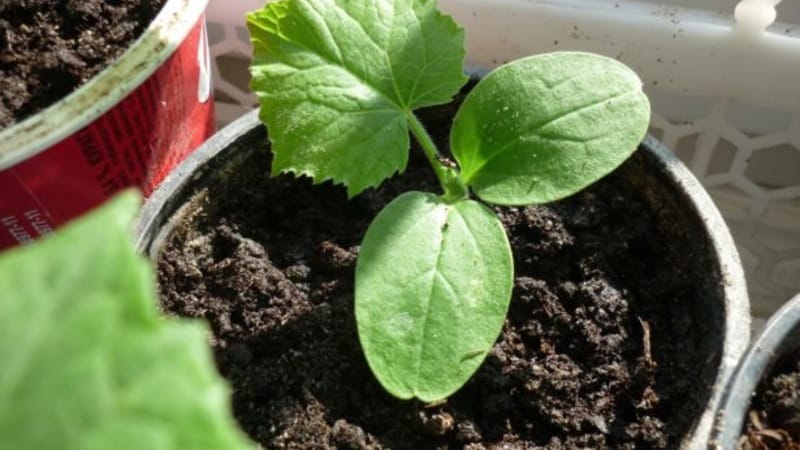 Seedlings require lighting, therefore, when shoots appear, the containers are immediately moved to the windowsill.For the first 3 days, seedlings need round-the-clock lighting, so you should take care in advance about lighting at night. Phytolamps are installed as additional lighting.
Seedlings require lighting, therefore, when shoots appear, the containers are immediately moved to the windowsill.For the first 3 days, seedlings need round-the-clock lighting, so you should take care in advance about lighting at night. Phytolamps are installed as additional lighting.
The temperature is reduced to 20-22 °C, since at higher temperatures the sprouts stretch and weaken.
Water as the top layer of soil dries out from a shallow watering can or with a regular tablespoon of warm, settled water. Cold water can cause young roots to rot. Seedlings should not be flooded, as stagnant moisture increases the risk of developing a disease called blackleg.
Reference! Blackleg is a disease of fungal etiology. Characterized by darkening of the lower part of the stem, near the ground. The disease is dangerous because it destroys all plantings in a short period of time.
After watering, the soil is loosened superficially so as not to damage the young roots. Oxygen, which is necessary to strengthen the immune system, penetrates better into loosened soil.
In the middle of the seedling period, the seedlings are fed with liquid fertilizer for cucumber seedlings. Second feeding performed before transplantation to a permanent place.
Transplantation to a permanent place
A month later, the seedlings are ready to be transplanted to a permanent location. Replanting is carried out at a soil temperature of at least 16 °C. In cold soil, the roots begin to rot and the seedlings die.
The ideal soil for Satina is loamy. Loamy soil is breathable, which is necessary for the full development of cucumbers.
Planting pattern:
- in the greenhouse: 60 cm – row spacing, 15 cm – between seedlings;
- in open ground: 60 cm – row spacing, 60 cm – between seedlings.
The length of the rows is 60-70 cm.Before transplanting, the soil is dug up and a complex of mineral fertilizers is applied. After planting, the holes are watered with warm, settled water and left for a week without watering or fertilizing so that the seedlings take root in a new place.
Further care for Satin cucumbers
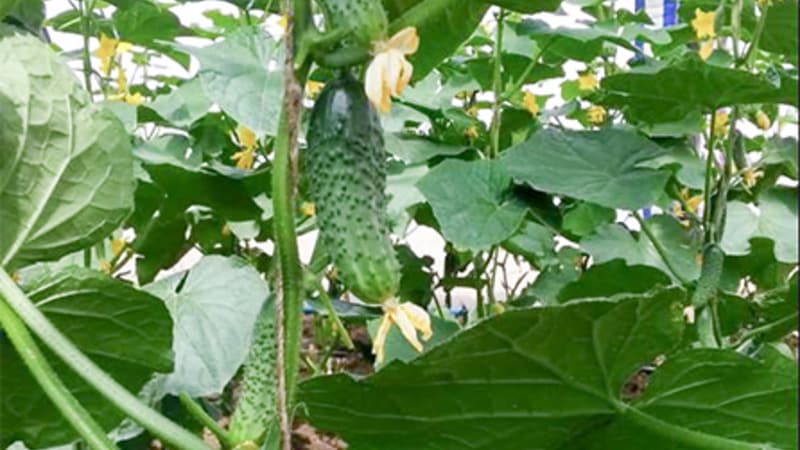 Timely and regular watering, loosening and weeding of the beds are important for cucumbers.. Water as the top soil layer dries under the roots of the plants, without flooding the seedlings or getting on the leaves.
Timely and regular watering, loosening and weeding of the beds are important for cucumbers.. Water as the top soil layer dries under the roots of the plants, without flooding the seedlings or getting on the leaves.
In the daytime, in the midday sun, the leaves can get seriously burned, so watering is carried out in the evening. To keep the beds moist longer, they are mulched with straw or sawdust.
Best watering – drip. With such watering, the plants do not lack moisture, and when breeding the hybrid in greenhouse conditions, the temperature and humidity levels do not exceed the norm.
After watering, the beds are loosened and weeded. Weeds take a lot of nutrients from the ground, which adversely affects the further development of seedlings. The weeds are home to a large number of pests that are dangerous to cucumbers.
The crop is fed three times during the entire growing season:
- During flowering, a complex of mineral substances with a predominant content of phosphorus and nitrogen is introduced.
- At the time of fruit set, it is possible to add organic matter (mullein infusion 1:15).
- During fruiting, potassium salts are added to the fertilizer for faster fruit ripening.
Features of care and possible difficulties
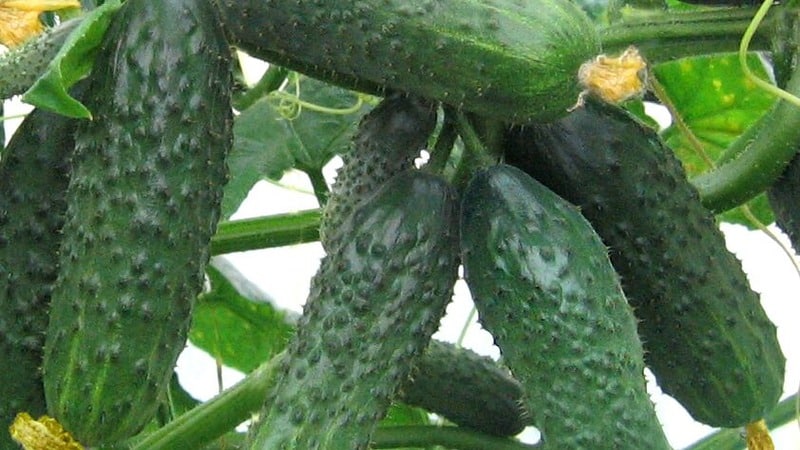
When 5-7 leaves appear, the seedlings are tied to a net. Every 4 meters in a row, metal supports are installed, between which wire is pulled. A plastic mesh is attached to the wire.
Plants are formed into 1 stem, removing all other shoots.This is necessary to obtain maximum yield. Shoots are removed regularly once every 10 days.
Diseases and pests
The culture is resistant to many dangerous diseases, but improper care can cause the development of fungal infections. For plant health, it is necessary to follow the rules of crop rotation, which recommend planting cucumbers in those beds where onions, cabbage, carrots, and legumes previously grew. After these crops, pathogenic organisms dangerous to cucumbers do not remain in the soil. In addition, legumes saturate the soil with nitrogen, which is necessary for the growth of crops from the pumpkin family.
To strengthen the immune system, experienced gardeners water the seedlings with biological products (Fitosporin, Gamair, Phytocid). These drugs prevent fungal diseases.
To destroy whiteflies and aphids, which are dangerous to seedlings, the chemical insecticide “Aktara” is used. But if there are few pests, then traditional methods will help, for example: treating the leaves and stems with a soap solution. The solution is prepared from 1 piece of laundry soap dissolved in a bucket of warm water. For the whitefly butterfly, pheromone traps are placed in the area, which capture only the pest without causing harm to other insects.
Reference! Pheromone traps can be purchased at any specialized gardening store.
Harvesting and application
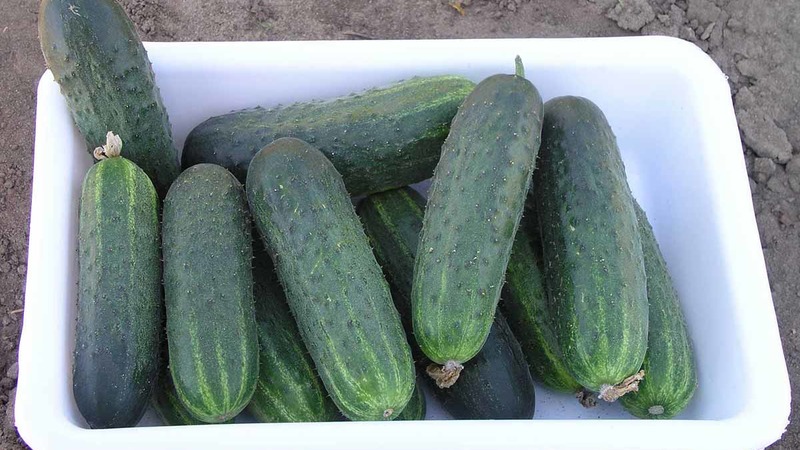
The ripening of the fruits is uniform, almost all of them are the same size and have an excellent presentation.
At least 95% of the total harvest is sold, so the hybrid is beneficial for commercial purposes. The presentation is preserved regardless of the duration of transportation.
Ripe vegetables are used for preparing fresh dishes and for pickling, marinades And conservation. Cucumbers can withstand any heat treatment and do not crack.
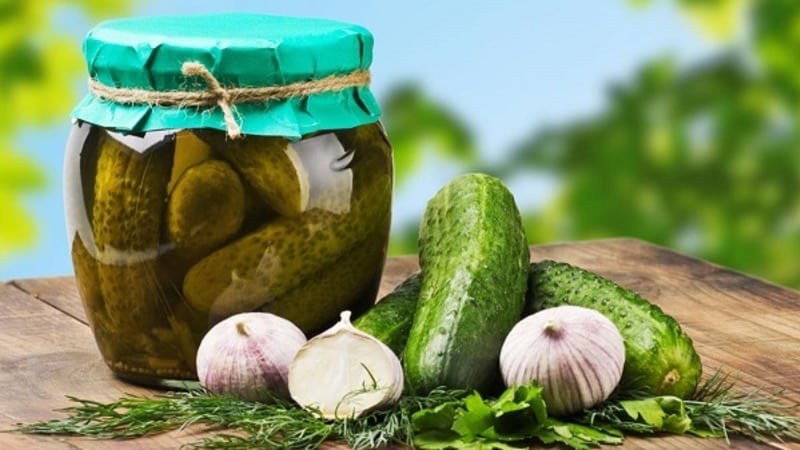
Advantages and disadvantages
Thanks to its undeniable advantages, the variety is known in almost all regions of our country:
- the possibility of propagation in 2 ways - without seedlings and through seedlings;
- easy to care for;
- high productivity;
- stable immunity to diseases;
- amicable maturation;
- excellent taste;
- universal application;
- long preservation of presentation;
- possibility of breeding on an industrial scale;
- high demand in sales markets.
Among the disadvantages is the impossibility of independently collecting seeds and the need to form bushes to increase productivity.
Farmer reviews
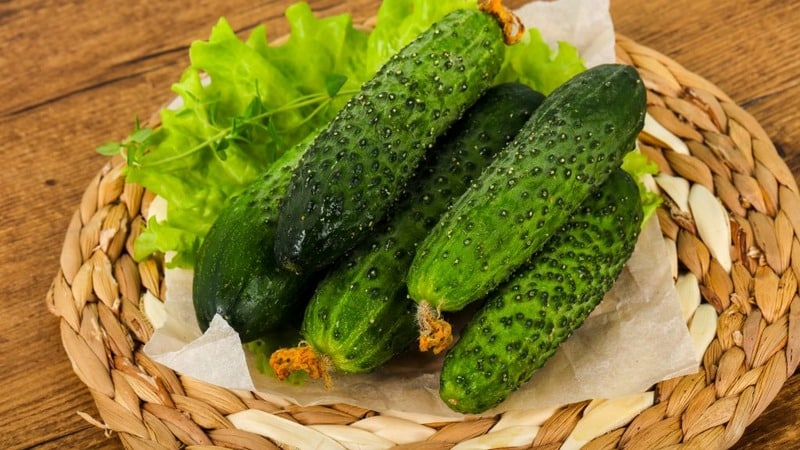
The hybrid has earned the trust of not only gardeners, but also buyers of finished products. It is not difficult to grow the crop, and ready-made cucumbers are sold at markets at an affordable price.
Lyudmila, Saransk: “I liked the hybrid because it can be marinated in all sorts of ways. Care during the growing season is simple: just water, loosen, weed and feed on time. I buy Satin cucumber seeds at a seed store at a reasonable price.”
Claudia, Novocherkassk: “Satina are my favorite cucumbers because they are the most delicious and easiest to care for. I make fresh salads and winter preparations from ripe cucumbers. The hybrid has never failed, I always have a harvest, the cucumbers look like the photo on the package. This is not the first year I’ve been planting it, nor will it be the last.”
Conclusion
Hybrid Satin f1 has numerous advantages: high yield, strong immunity and ease of care during the entire growing season. Even if this is the first time you have decided to plant cucumbers on your plot, this hybrid will completely satisfy all your needs.